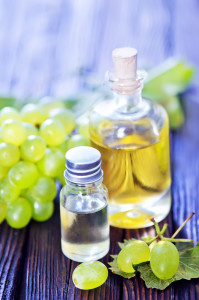Written by Greg Arnold, DC, CSCS. A grape seed extract, when applied to the face of 110 healthy men, significantly decreased skin pigmentation and oily skin by 10% and 21% respectively while significantly improving skin elasticity by 5% compared to control.
 One of the most visible signs of aging is the appearance of our skin. Damage to skin is caused by free radicals produced in the body (such when we breathe) but also from the outside environment in the form of cigarette smoke, pollution, and ultraviolet radiation form (from) the sun 1. Free radicals proceed to break down enzymes in the skin 2, damage DNA and also parts of cells that may eventually kill the cell or make it very dysfunctional 3,4. The damage to cells is reflected in the skin roughness, wrinkling, dryness and pigmentation changes that characterize aging skin 5,6.
One of the most visible signs of aging is the appearance of our skin. Damage to skin is caused by free radicals produced in the body (such when we breathe) but also from the outside environment in the form of cigarette smoke, pollution, and ultraviolet radiation form (from) the sun 1. Free radicals proceed to break down enzymes in the skin 2, damage DNA and also parts of cells that may eventually kill the cell or make it very dysfunctional 3,4. The damage to cells is reflected in the skin roughness, wrinkling, dryness and pigmentation changes that characterize aging skin 5,6.
As a result, finding ways to help decrease free radical damage to the cells in the skin is one way to keep our skin healthy and minimize the aging process. Now a new study 7 suggests that extract from Muscat hamburg, a blueblack table grape commonly found in Asia, North America and Europe 8 may be beneficial to skin health. The study involved 110 healthy males aged 25 to 27. They applied a cream containing the Muscat hamburg on one cheek over a 4 centimeter x 4 centimeter patch of skin and then a placebo cream on the other cheek in an ‘occlusive patch test’ twice daily for 8 weeks. Each subject had a clinical skin examination examined on a weekly basis to check for changes in skin quality.
After 8 weeks, the researchers noted three significant improvements in the grape group compared to the placebo group:
- An 18% decrease in irregular skin pigmentation compared to an 8% increase in the placebo (p < 0.05).
- A 12% increase in skin elasticity compared to a 7% decrease in the placebo group (p < 0.05).
- A 15% decrease in oily skin (sebum concentration) compared to a 6% increase in the placebo group (p < 0.05).
When suggesting how the Muscat hamburg elicited these healthful effects on skin, the researchers cited “the presence of a large number of phyto-oxidants both in the peel and skin” 9,10 that are able to minimize free radical damage to the skin. They concluded that “the antioxidant-rich formulation is beneficial for its safe use as natural skin whitening, moisturizer and as a potential anti-aging agent” and that “This active and stable formulation could also be able to decrease erythema effects and skin sebum content, without causing any skin sensitivity” as well as “diminishing skin redness and acne vulgaris, a common human skin condition among worldwide populations.”
Source: Sharif A. Formulation and evaluation on human skin of a water-in-oil emulsion containing Muscat hamburg black grape seed extract. Int J Cosmet Sci. 2015 Apr;37(2):253-8. doi: 10.1111/ics.12184. Epub 2014 Dec 16
© 2014 Society of Cosmetic Scientists and the Société Française de Cosmétologie.
Posted August 2, 2016.
Greg Arnold is a Chiropractic Physician practicing in Hauppauge, NY. You can contact Dr. Arnold directly by emailing him at PitchingDoc@msn.com or visiting his web site at www.PitchingDoc.com
References:
- Ross FP, Christiano AM. Nothing but skin and bone. The Journal of clinical investigation. 2006;116(5):1140-1149.
- Ndlovu G, Fouche G, Tselanyane M, Cordier W, Steenkamp V. In vitro determination of the anti-aging potential of four southern African medicinal plants. BMC Complement Altern Med. 2013;13:304.
- Masson C, Menaa F, Pinon-Lataillade G, et al. Global genome repair is required to activate KIN17, a UVC-responsive gene involved in DNA replication. Proc Natl Acad Sci U S A. 2003;100(2):616-621.
- Masson C, Menaa F, Pinon-Lataillade G, Frobert Y, Radicella JP, Angulo JF. Identification of KIN (KIN17), a human gene encoding a nuclear DNA-binding protein, as a novel component of the TP53-independent response to ionizing radiation. Radiat Res. 2001;156(5 Pt 1):535-544.
- Ali A, Akhtar N, Khan HMS. Enhancement of human cheek skin texture by Acacia nilotica bark extract cream. Tropical Journal of Pharmaceutical Research. 2013;12(3):323-327.
- Menaa F, Menaa A. Progressive genetic architecture of human skin pigmentation. J Primatol. 2013;3:116.
- Sharif A, Akhtar N, Khan M, et al. Formulation and evaluation on human skin of a water‐in‐oil emulsion containing Muscat hamburg black grape seed extract. International journal of cosmetic science. 2015;37(2):253-258.
- Terral JF, Tabard E, Bouby L, et al. Evolution and history of grapevine (Vitis vinifera) under domestication: new morphometric perspectives to understand seed domestication syndrome and reveal origins of ancient European cultivars. Annals of botany. 2010;105(3):443-455.
- Aziz MH, Afaq F, Ahmad N. Prevention of ultraviolet-B radiation damage by resveratrol in mouse skin is mediated via modulation in survivin. Photochemistry and photobiology. 2005;81(1):25-31.
- Bunea CI, Pop N, Babes AC, Matea C, Dulf FV, Bunea A. Carotenoids, total polyphenols and antioxidant activity of grapes (Vitis vinifera) cultivated in organic and conventional systems. Chem Cent J. 2012;6(1):66.
